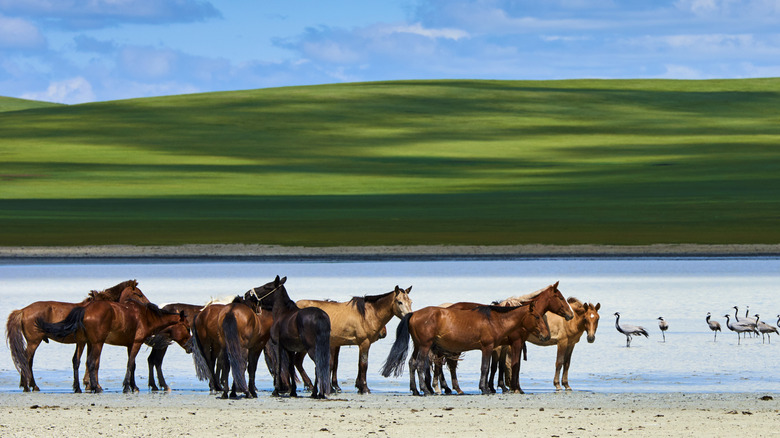Avoid Crowds At One Of Asia's Most Underrated Pristine Wonders Filled With Nomadic Charm
While the ills of overtourism have been dominating the headlines in recent years, there are still plenty of destinations where you're guaranteed to escape the crowds. For a perfect example of this, look no further than Mongolia, the large, landlocked Asian nation that offers sweeping vistas, untouched nature, and nomadic locals known for their indomitable spirit and warm hospitality.
Mongolia is one of the most sparsely populated countries on earth, with just five people per square mile. To put this in perspective, the state of Rhode Island is home to one-third the number of people as Mongolia but has a population density of 1,018 people per square mile. Home to mighty rivers, sparkling lakes, pine forests, ancient mountains, wide steppes, and the immensity of the Gobi Desert, Mongolia is a must-see destination for adventurous travelers seeking to commune with nature. A visit to this part of the globe also affords guests the opportunity to stay with local nomads and witness their mostly unchanged way of life, firsthand.
But for all of its splendors, Mongolia isn't the easiest place to travel to or within. Public transport is rudimentary, and outside of the gritty but surprisingly dynamic capital of Ulaanbaatar, the infrastructure quickly goes from rough to often nonexistent. While it's possible to rent a car, given the rough state of the roads, it's best to hire a driver. Mongolian is the primary language, and English is barely spoken, making the need for a guide with interpreting skills very real, and winter temperatures can plunge well below zero degrees Fahrenheit. This means that planning the details of your trip is essential, but for travelers willing to put a bit of work in at the front end, Mongolia offers an unforgettable experience unlike anywhere else on the planet.
Nature for miles
While Ulaanbaatar warrants a day or two of exploration, Mongolia reveals its true charms in the open country. Just make sure to stock up on tugrik at one of the ATMs or exchanges before heading out, as outside of the capital it's pretty much a cash-only economy. Shoot over to Gorkhi Terelj National Park, which is about a two-hour bus ride from the capital. This massive nature reserve is home to pine trees and gorgeous, almost psychedelic rock formations that at times bring to mind the scenery of the American West. On the way there, you should check out the towering statue of Genghis Khan, a 131-foot-high tribute to Mongolia's national hero.
Southern Mongolia is home to much of the Gobi Desert, which, at half a million square miles, is the world's fifth largest. Many tour companies offer trips to the Gobi, where visitors can ride bactrian camels, marvel at the otherworldly sunsets, and sleep under a glimmering tapestry of stars completely unaffected by light pollution.
To experience Mongolia's pristine lakes, head out to Terkhiin Tsagaan (White Lake) in the country's interior, home to an extinct volcano and a haven for birdwatchers. Also, don't skip Lake Khovsgol in the north. Rimmed by rugged mountains, this frigid, azure, deep body of water is Mongolia's largest and also hosts the sole ship in the Mongolian Navy, which is available for cruises during the summer months. For experienced equestrians, the Khovsgol region can also be used as a jumping-off point for horseback treks to visit the Tsaatan reindeer herders who live deep in the raw and remote Darkhad Valley.
A vibrant, ancient culture
Nature is the name of the game in Mongolia, but this also goes hand-in-hand with people who enjoy a way of life going back thousands of years. One of the best ways to experience the culture is by visiting in July during the Naadam Festival. This multi-day celebration features time-honored Mongolian pursuits including archery, horseback racing, and wrestling. While Ulaanbaatar is home to the biggest and most famous Naadam celebration, nothing beats experiencing the festival in a smaller, regional town for a nice dose of local flavor.
Most anyone who visits the country should also make time to stay with a local nomadic family, which can be arranged by an array of tour companies. Be sure to download a good app like Google Translate, since they may not speak any English. Life in the ger (the Mongolian word for yurt) is simple and cozy, and guests will often be asked to help out with basic chores. They'll also share hearty meals with their hosts that will more than likely involve a bowl or two of airag, the fermented horse milk central to Mongolian cuisine.
While summer is the ideal time to visit, fall can be rewarding as well, especially for those who make the effort to attend the annual Golden Eagle Festival. Held in October in western Mongolia's remote Bayan-Ulgii province, this gathering features hundreds of Kazakh eagle hunters who showcase their skills and traditions for both visitors and the local community. It's a photographer's dream, but make sure to book early as accommodations quickly fill up.


